TIME
|
EVENT
|
| 1799 | Sir George Cayley, a baronet in Yorkshire, near Scarborough, England, conceives a craft with stationary wings to provide lift and "flappers" to provide thrust. It also has a movable tail to provide control. So convinced is he that this idea is an earth-shaker, he engraves a drawing of this craft on a silver disk. Cayley is the first to separate the different forces that keep an aircraft in the air, and his engraving is the first recorded drawing of afixed-wing aircraft -- an airplane.
|
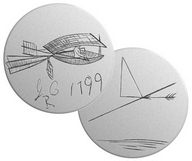
Cayley's engraved disc — The front shows his design for a fixed-wing aircraft, the back shows how thrust is used to generate lift and overcome drag.
|
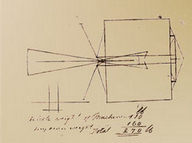
The is the top view of Cayley's airplane from his notebook, along with his estimate of its weight. The inset shows how it might have looked had it been built.
|
| 1804 | Sir George Cayley, England, builds a miniature glider with a single wing and a movable tail mounted on a universal joint. It also has a movable weight to adjust the center of gravity. It is the first recorded fixed-wing aircraft of any size capable of free flight.
|

In 1804, Cayley recorded this design for a small fixed-wing glider in his notebook.
|

A replica of Cayley's 1804 aircraft — it's basically just a kite on a stick
|
| 1809 | Sir George Cayley builds a man-sized version of a glider with a wing surface of 300 feet. An assistant makes a few tentative hops in the air, holding onto the stick fuselage.Sir George Cayley publishes On Aerial Navigation, a three-part article which appeared in Nicholson’s Journal of Natural Philosophy. It is a milestone and for the first time defines the three elements required by an aircraft — lift, propulsion, and control.
|
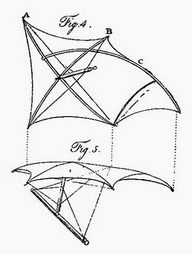
Cayley's 1809 glider was similar to a modern hang glider.
|
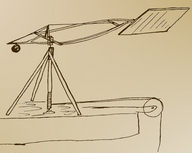
The articles in Nicholson's Journal also described Cayley's "whirling arm" experiments. It was the first time anyone had measured the lift generated by wing surfaces.
|
| 1810 | Thomas Walker, a portrait-painter from Hull, England publishes a pamphlet on the possibilities of fixed-wing aviation. In it is a design for an airplane that at first appears similar to Cayley's 1799 vision. But what looks like a single wing is actually composed of 8 long slender wings that overlap one another. The control system adjusts the angle of attack of the winglets. This, in turn, varied the lift and caused the airplane to ascend or descend. Or so Walker hypothesized. |

Walker's aircraft design had a stick control that increased or decreased the lift.
| |
1810-
1840 | Sir George Cayley tries three times to organize an aeronautical society in England to study the problems of flight and advance the science of aeronautics, but finds little interest among English scholars. Despite the recent success of aerostation (lighter-than-air balloons), the topic of heavier-than-air flight still has the stigma of the crackpot attached to it.
|
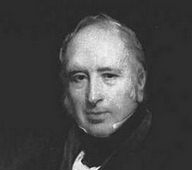
Sir George R. Cayley.
| |
| 1831 | Thomas Walker revises his 1810 pamphlet and proposes a tandem-wing airplane with the pilot and the propulsion system amidships. Gone are the rows of winglets; each wing is a solid curved surface. Walker proposes that two sets of wings – one forward, one back – will balance the load in the air. Much later, Walker's design will later influence Samuel Langley as he builds and tests his "aerodromes" at the Smithsonian Institution in America.
|

The small movable wings between the two larger sets of fixed wings are "oars." Walker intend for his aircraft to be rowed through the sky.
| |
| 1843 | William Samuel Henson, England, proposes the Aerial Steam Carriage in Mechanics Magazine. It is the first known design for a propeller-driven fixed-wing aircraft. Although the full-size aircraft is never built, the concept helps popularize Cayley's vision of fixed-wing aircraft and has tremendous influence on the subsequent development of aviation. Henson's request to form an "Aerial Transport Company" is rejected by the House of Commons amid much laughter.
|
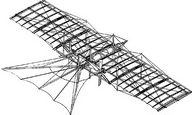
The patent drawing for Henson's aircraft showed a ribbed wing with spars supporting the load. This design will become standard wing construction.
|
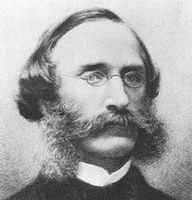
William S. Henson.
|
1845-
1848 | William Samuel Henson and John Stringfellow successfully form the Aerial Transit Company, which (if only they had a practical airplane), would have been the world's first airline. To drum up support, they build and test a model of Henson's aerial carriage with a 20-foot wingspan. It makes brief powered glides of up to 130 feet (40 meters), but does not sustain flight.
|
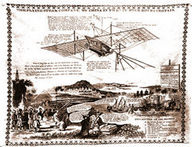
A scarf with a silk-screened ad for the Aerial Transit Company.
|
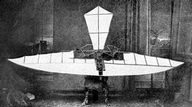
Stringfellow's model of the Aerial Steam Carriage.
|
| 1849 | Sir George Cayley builds a small triplane glider designed to lift about 80 pounds of the ground. History remembers it as the "boy glider," although Cayley seemed to think of it as a "governable parachute." It is the first recorded manned (or boyed) fixed-wing aircraft. A group of people tow it aloft, lifting a 10-year old boy off the ground for a short distance. Cayley also flew the craft in a high wind like a kite, tethered to the ground.
|
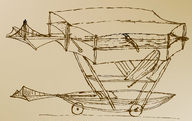
The boy glider had two small flappers, one on either side, which were intended to balance the aircraft, not propel it.
|
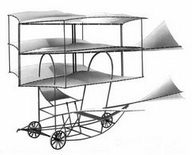
An artist's depiction of Cayley's "boy glider." The control sticks should be connected by bell-cranks to the flappers.
|
| 1852 | In France, aeronaut Jules-François Dupuis-Delcourt organizes the Société Aérostatique et Météorologique de France, the first scientific body to study aviation. Later, this evolves to become the Société Française de Navigation Aérienne.
|

Jules-François Dupuis-Delcourt.
| |
| 1853 | Sir George Cayley builds an improved version of his glider and convinces his coachman to pilot it. The coachman, whose name is lost to us, makes an wavering, uncontrolled glide of a few hundred feet across Brompton Dale – the world’s first true manned flight in a fixed-wing aircraft. The coachman quits Cayley’s service immediately after his one and only feat of airmanship, reportedly saying, "I wish to give notice, sir -- I was hired to drive, not to fly."Louis Charles Letur builds and tests a parachute-glider, demonstrating it in both England and France. These are the firstcontrolled flights in a heavier-than-air machine. After several successful descents, Letur has a serious accident and dies of his injuries.
|
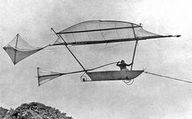
Derek Piggot bravely flies a replica of Cayley's 1853 glider for a British documentary.

Letur's glider was controlled by ropes attached to cloth vanes.
|

Cayley published his design for a "governable parachute" inMechanics Magazine.
|
![THE FIRST AIRPLANES, THE CENTURY BEFORE]() Reviewed by Unknown
on
21:26
Rating:
Reviewed by Unknown
on
21:26
Rating:

 Welcome to our Expert community, How many questions do you have about excel? are you still serching for an answer? dont worry ask any questions and get answer instantly.
Welcome to our Expert community, How many questions do you have about excel? are you still serching for an answer? dont worry ask any questions and get answer instantly.

























No comments: